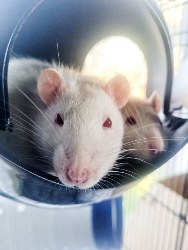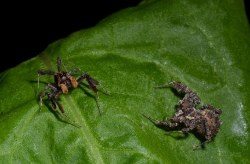Gene Testing Reveals Secrets To Kākāpō Protection
Research has just been published revealing the cause of the 2019 kākāpō pandemic.
Professor Peter Dearden, Director of Genomics Aotearoa, likens it to a detective story.
“Genomics is the study of the genome, that’s all the DNA that makes up something. We used genomics to sample and test the whole island where the outbreak took place. Everything. From the dead kākāpō, the nests, the feeding areas, to boats, clothing, beaches, people, and equipment. And we found a single strain of aspergillus. This is weird, really weird, because usually even in just a single patient we would see multiple strains of aspergillus – but here it was just a single strain. It was so weird in fact that the journal we submitted the research to initially rejected our study. This is just unheard of. And because it was kākāpō dying, and because the findings that showed this single strain was so unusual, when someone sent out a tweet about it, we got scientists, doctors, geneticists, and immunologists from around the world contributing their time and expertise to the study”
Researchers from Imperial College London, Manchester University, University of California, the University of British Columbia, and hospitals in the Netherlands and across New Zealand contributed to the study; piecing together the puzzle that wiped out a swathe of these beloved flightless parrots.
Before the 2019 pandemic, only one kākāpō had ever died of aspergillosis in decades, there had never been any problem with the pathogen; suddenly it was everywhere.
Aspergillus is black mould, and it is ubiquitous. On bathrooms windows, in the soil; there are probably several strains in your body right now. For most people, and kākāpō, aspergillus is seen as relatively harmless. But for the immunosuppressed, or in high doses, it is deadly.
In the middle of what had been heralded as a record breeding year, Department of Conservation workers suddenly recognised disease was sweeping through the breeding ground on Whenua Hou (Codfish Island). At the height of the outbreak, in April 2019, Dr Andrew Digby, contacted Genomics Aotearoa as almost half of the entire global population at the time were taken from sanctuary islands and transferred to veterinary hospitals on the mainland for treatment.
They needed to find out the what, the why, and the how, and that is when the barrage of testing started.
Sampling and testing genome-wide allows researchers to study the origin and dynamics of disease outbreaks in much greater detail than other forms of testing. While previously CT scans may have been needed to test for aspergillosis, now a single cell – a hair – or a feather, is all it takes to give a deluge of data.
The research team grew strains from the environment and clinical samples and then sequenced them to reveal the sad truth. in trying to save the kākāpō, the evidence suggested we may have been harming them.
“We think the strain had something to do with the feeding, certainly something that humans carried onto the island and spread”, said Professor Dearden.
While the feeding may have been the source, climate change may have also played a part in exacerbating the situation into a perfect storm. 2019 was a particularly warm summer; and a hot, dusty environment is what aspergillus thrives in. Duplicating and growing into what would be massive doses for vulnerable kākāpō. Doses too high for many to survive.
As the impacts of climate change are increasingly felt, and as transmissible diseases increase around the planet, for people and animals, genomic sequencing is the way we can understand and manage these outbreaks.
For kākāpō, this information has led to changes in the way we manage their survival.
“This research into the 2019 kākāpō aspergillosis outbreak has provided information which may prove vital for kākāpō conservation. By providing clues as to what may have caused the outbreak, these findings can help us to alter management to minimise the risk to future breeding seasons, and to the population”, said Dr Andrew Digby, Science Advisor Kākāpō/Takahē at the Department of Conservation.
Now, DOC manage their care differently. They are more cautious about human contact, they are more hands-off, and they don’t foster chicks between nests as often to avoid giving and spreading disease.
But this research was successful for more than the protection of a taonga species, it showed how scientists across different disciplines and countries can come together to solve a puzzle and add to global knowledge.
Last author, Professor Murray Cox said, “This research project ran exactly how research projects ideally should. There was a national problem; everyone jumped on board; things happened; and we got crucial practical information out to the conservation team really fast. We achieved this largely because we worked outside the official structures and systems that slow research down so much in New Zealand, like the siloing of institutions, slow lengthy paperwork, and grant application processes that take well over a year before research can even start.”
Dr Digby agreed, “The collaboration was amazing and inspirational”.
“It is how science should be done”, added Professor Dearden.
About Genomics Aotearoa
Genomics Aotearoa is an agile, leading-edge and collaborative platform, established to ensure that Aotearoa New Zealand is internationally participating and leading in the rapidly developing fields of genomics and bioinformatics.


 Business Canterbury: Urges Council To Cut Costs, Not Ambition For City
Business Canterbury: Urges Council To Cut Costs, Not Ambition For City Wellington Airport: On Track For Net Zero Emissions By 2028
Wellington Airport: On Track For Net Zero Emissions By 2028 Landcare Research: ANZAC Gall Fly Release Promises Natural Solution To Weed Threat
Landcare Research: ANZAC Gall Fly Release Promises Natural Solution To Weed Threat NZ Anti-Vivisection Society: Auckland Rat Lovers Unite!
NZ Anti-Vivisection Society: Auckland Rat Lovers Unite! University of Canterbury: $1.35 Million Grant To Study Lion-like Jumping Spiders
University of Canterbury: $1.35 Million Grant To Study Lion-like Jumping Spiders Federated Farmers: Government Ends War On Farming
Federated Farmers: Government Ends War On Farming



